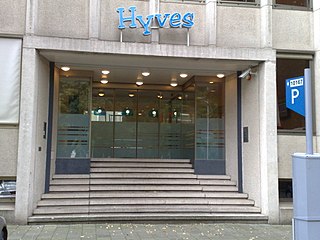Related Research Articles
Slashdot is a social news website that originally billed itself as "News for Nerds. Stuff that Matters". It features news stories on science, technology, and politics that are submitted and evaluated by site users and editors. Each story has a comments section where users can add online comments.
Plastic.com (2001–2011) was a general-interest internet forum running under the motto 'Recycling the Web in Real Time'.

Hyves was a social networking site in the Netherlands with mainly Dutch visitors and members, where it competed with sites such as Facebook and MySpace. Hyves was founded in 2004 by Raymond Spanjar and Floris Rost van Tonningen. The service was available in both Dutch and English.
A social news website is a website that features user-posted stories. Such stories are ranked based on popularity, as voted on by other users of the site or by website administrators. Users typically comment online on the news posts and these comments may also be ranked in popularity. Since their emergence with the birth of Web 2.0, social news sites have been used to link many types of information, including news, humor, support, and discussion. All such websites allow the users to submit content and each site differs in how the content is moderated. On the Slashdot and Fark websites, administrators decide which articles are selected for the front page. On Reddit and Digg, the articles that get the most votes from the community of users will make it to the front page. Many social news websites also feature an online comment system, where users discuss the issues raised in an article. Some of these sites have also applied their voting system to the comments, so that the most popular comments are displayed first. Some social news websites also have a social networking service, in that users can set up a user profile and follow other users' online activity on the website.
VideoSift is a video aggregator designed to showcase unique and interesting videos, the name of the site being a direct allusion to the metaphor of sifting wheat from chaff. It was founded by Brian Houston in February 2006, who was joined by James Roe and Rommel Santor as co-creators. Members submit embedded videos from other websites, such as YouTube and Google Video, which are then ranked according to a social-voting system similar to and inspired by Digg. Nicknamed the Sift, VideoSift aims to provide its users with the best available online video content through a consistent and attractive interface, responding to the problems of videos being scattered among many different sources, each having arguably difficult or unintuitive user interfaces.

Fark is a community website created by Drew Curtis that allows members to comment on a daily batch of news articles and other items from various websites. The site receives many story submissions per day and approximately 100 of them are publicly displayed on the site, spread out over the main page as well as topical tabs that are organized as entertainment, sports, geek, politics and business). Curtis says the stories are selected without intentional political bias, but that he tries to run both far-left and far-right articles.

Digg, stylized in lowercase as digg, is an American news aggregator with a curated front page, aiming to select stories specifically for the Internet audience such as science, trending political issues, and viral Internet issues. It was launched in its current form on July 31, 2012, with support for sharing content to other social platforms such as Twitter and Facebook.
Porn 2.0, is named after "Web 2.0", refers to pornographic websites featuring user-generated content, including social networking features such as user-based categorizing, webcam hosting, blogs and comments. This is in contrast to the static content offered by "Web 1.0" porn sites. Porn 2.0 sites may offer features similar to mainstream Web 2.0 services such as video communities, social sites,, general blogging platforms, and photo hosting services.

Dipdive was a social networking website created by will.i.am. It is best known as the original source site of the 'Yes We Can' music video. The site allowed users to upload images, videos and audio files, post blog entries and create playlists. Dipdive was home to a variety of creative content and information on social causes.

Ravelry is a free social networking service and website that beta-launched in May 2007. It functions as an organizational tool for a variety of fiber arts, including knitting, crocheting, spinning and weaving. Members share projects, ideas, and their collection of yarn, fiber and tools via various components of the site.
Taringa! is an Argentine-based social networking site geared toward Hispanophone users.
DeviantArt is an online art community that features artwork, videography and photography, launched on August 7, 2000 by Angelo Sotira, Scott Jarkoff, and Matthew Stephens among others.
People of Walmart (PoW) is an entertainment website featuring user-submitted photos of Walmart customers considered to be socially awkward or undesirable by users of the site. PoW has been promoted largely on sites like Digg and Funny or Die, and linked on Facebook and Twitter. People of Walmart was founded in 2009 by brothers Andrew and Adam Kipple, and their friend Luke Wherry.
Sponsored post, also known as a promoted post, is a post to any community-driven notification-oriented website which is explicitly sponsored as an advertisement by a particular company in order to draw a large amount of popularity through user promotion and moderation to the most active or most viewed page on the website. The model has become adopted by various ad-supported but community-driven websites as an addition, substitute or replacement of other pay-per-click advertisement formats, such as web banners, text and rich media. Sites and services which utilize sponsored posts include Digg, Reddit, Twitter, and Instagram.

A like button, like option, or recommend button is a feature in communication software such as social networking services, Internet forums, news websites and blogs where the user can express that they like, enjoy or support certain content. Internet services that feature like buttons usually display the number of users who liked each content, and may show a full or partial list of them. This is a quantitative alternative to other methods of expressing reaction to content, like writing a reply text. Some websites also include a dislike button, so the user can either vote in favor, against or neutrally. Other websites include more complex web content voting systems. For example, five stars or reaction buttons to show a wider range of emotion to the content.
Weardrobe is an online street fashion community for both novice and established bloggers that allows members to share their outfits and comment on others' photographs.

8tracks.com is an internet radio and social networking website revolving around the concept of streaming user-curated playlists consisting of at least 8 tracks. Users create free accounts and can browse the site and listen to other user-created mixes, as well as create their mixes. The site also has a subscription-based service, 8tracks Plus, although this is currently only available to listeners based in the United States and Canada.
Shopcade was a social marketplace with a dual online platform offering a daily product shopping feed of top trends, products and deals, curated by influencers. The company used the social graph and artificial intelligence to make content shoppable. It also powered an analytics platform, analysing content to commerce engagement and sales.

We Heart It was an image-based social network. We Heart It describes itself as "A home for your inspiration" and a place to "Organize and share the things you love." Users could collect their favorite images to share with friends and organize into collections. Users can access the site through We Heart It's iOS and Android mobile apps.
References
- ↑ Oshiro, Dana (June 5, 2009). "Lookbook.nu: Digg for Fashion Insiders". ReadWriteStart. Archived from the original on December 28, 2009. Retrieved 2010-03-28.
- ↑ Moore, Booth (September 21, 2009). "Fashion's rules unraveling". The Chicago Tribune. Retrieved 2010-03-28.
- ↑ "Elle Belgium!".
- ↑ Collantes, Tracy (Aug 18, 2009). "She's Got The Look". Status. Retrieved 2010-03-28.
- ↑ Gardner, Jasmine (2009-09-14). "Is this going to be the new route to planet fashion?". London Evening Standard. Archived from the original on December 4, 2009. Retrieved 2010-03-28.